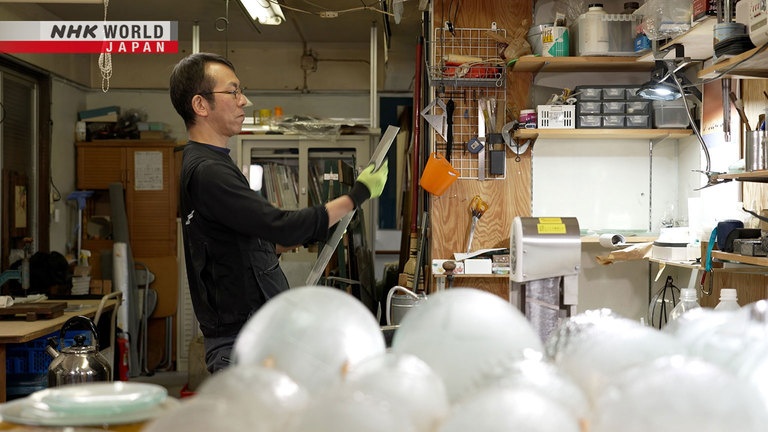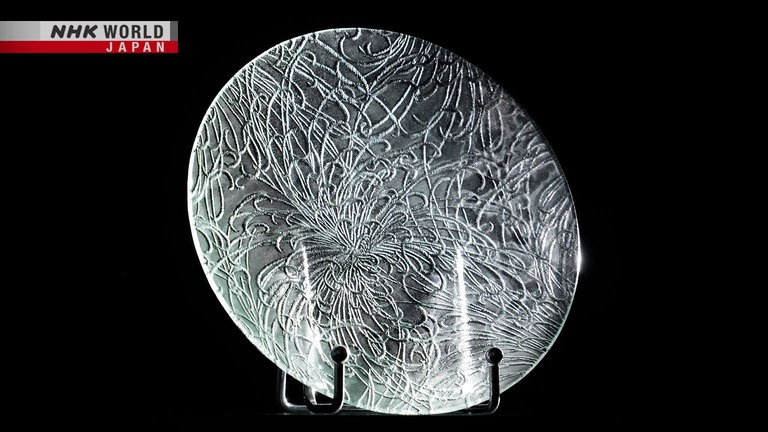Retro Panes to the Future
In the mid-20th century, glass panes featuring patterns like chrysanthemums or cherry blossoms were popular in Japanese homes. As older houses are demolished such glass is often discarded, but artisan Koyakata Yoshikazu has found new uses for it. By cleaning and then reshaping the patterned panes he turns what was once waste into stylish tableware. The retro designs have earned quite a following, ensuring the charm of yesterday will be appreciated by the next generation.



Transcript
Since ancient times, the Japanese have believed that a life force resides in all creations.
Valuing and caring for the things we use, a "Zero Waste Life."
Pointing the way to better living for a new era.
I just couldn't let it go to waste.
I mean, it's still useful.
Designing with that in mind,
seeing it transform into something beautiful...
that's truly wonderful.
Downtown Kobe.
No longer occupied, this old home is scheduled for demolition.
This is Koyakata Yoshikazu.
He's come to collect the home's glass fittings.
Bamboo grass. Designs differ by home.
So, seeing it firsthand is the only way.
In the mid-20th century, room partitions fitted with stylish patterned glass were a popular feature in Japanese homes.
The glass engravings added a touch of whimsey to daily life.
But due to increasing westernization of homes, demand for such fittings rapidly decreased.
And those already in use were increasingly being discarded.
These were probably replacement panes.
This gingko pattern is quite a rare find.
I'm pretty happy about it.
Koyakata runs a neighborhood glass shop in Kobe.
Repair and replacement are his main business.
But lately he has been putting his energy into another kind of work.
Making plates from the glass he's collected.
His designs that take advantage of the panes' beautiful patterns are increasingly popular, selling for as little as 10 US Dollars.
Even patterns like this.
It looks like a melon, right?
It's quite a faithful representation
of the wrinkles on the skin.
The variety is impressive, with over 70 distinct patterns, according to their creator.
Today too, he's working on a new design.
First, he removes the glass from the recovered fittings.
It's stained or something, discolored.
Long-used glass takes on the stains of daily life.
Based on the pattern, he carefully selects which portions to use.
Not every part is the same.
I put a lot of effort into choosing.
If the pattern is cut off or too few,
it won't appeal to the customer.
Once he's made his selection, he uses a tool called a circle cutter to remove the desired section of glass.
Once the cut edges are polished, he carefully cleans the glass in an acid bath.
It's then heated in a kiln.
For this, forms like these are used.
Once heated, the softened glass takes on the curve of the form, shaping it into a plate.
The temperature is adjusted throughout the process.
A completed glass plate.
With all the staining gone, the pattern stands out in all its glory.
It really is quite a striking pattern.
Koyakata is the 3rd-generation owner of this 90-year-old glass shop, having taken over from his father 20 years earlier.
But the poor economic climate in Japan at the time saw business decline for the small local glass shop.
He knew he had to do something, and that's when he made a discovery.
On a shelf in the store there was a large quantity of patterned glass material.
The disused panes had been put there by his father.
That was just like my dad.
He hated to let things go to waste.
He thought it might have a use.
So, he kept on collecting more.
There must have been hundreds.
After the big quake in 1995
much of it was broken.
But he took the good panes and
put them all back on the shelf.
Koyakata found the patterns fascinating.
I wanted to find some way to use them.
That's when he came upon the idea of making them into dinner plates.
With the textured pattern on only one side, they were ideally suited to the purpose.
Beautiful! I thought they were beautiful.
The patterns had so much depth
compared to the original flat panes.
Since then, they'd been selling steadily for over 15 years.
But after photos of the plates appeared on social media two years ago, their popularity exploded, receiving over 2,000 orders in just a few days.
The patterned-glass plates became their signature product.
It was five years since the death of his father.
I don't think he ever imagined
the scrap glass he'd collected...
would sell quite so well
as plates or lampshades.
I'm sure he'd be very pleased.
In addition to the stylish tableware, Koyakata also produces lampshades from patterned glass.
He draws up a detailed plan for every design.
How to best show off the pattern,
so it looks good as a lampshade...
this is what I consider
as I'm drawing up the design.
I try my best to make things
people will want to use every day.
That's the kind of thing I create.
Koyakata's work has earned one especially dedicated group of fans.
The Hirakis.
His lampshades illuminate the family dining table.
Which one's your favorite?
This one.
Chrysanthemums for mom.
It's so pretty!
Snack time with their favorite plates.
The Hirakis have over 20 of Koyakata's plates in their home.
I remember the glass like this
in my grandmother's house.
When I built my own home
I wanted a touch of nostalgia.
And plates like these are
something I can use every day.
The lampshades too.
The girls both have
their favorite patterns.
The reborn glass truly shines in its new home.
I believe I'm truly blessed.
I'm so lucky that my father
left me all that glass.
And there are still many old houses
where there's more of it waiting.
With a little ingenuity it can have
new appeal and find new uses.
So, I do my part to spread the word.